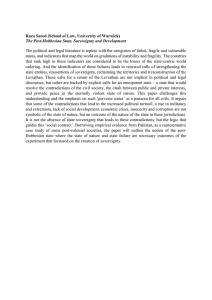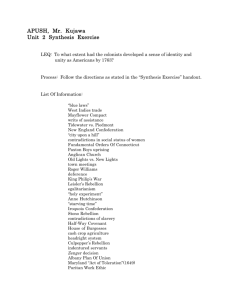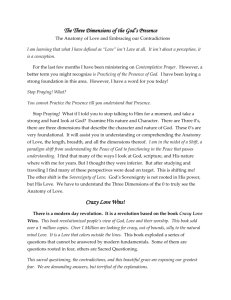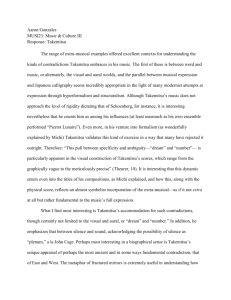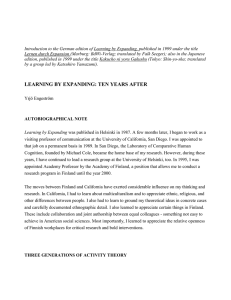Designing usable collaborative e-mail using activity theory Dr. Lorna Uden Staffordshire University,
advertisement
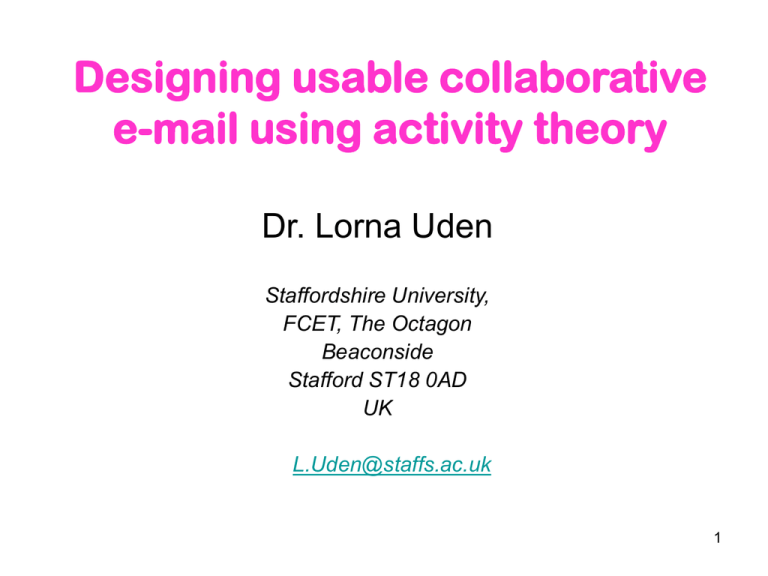
Designing usable collaborative e-mail using activity theory Dr. Lorna Uden Staffordshire University, FCET, The Octagon Beaconside Stafford ST18 0AD UK L.Uden@staffs.ac.uk 1 Contents • • • • Introduction Email Activity theory Requirements analysis for collaborative e-mail design using AT • Conclusions 2 Introduction • Email, List Servers, Newsgroups, Web Conferencing, Internet Relay Chat (IRC), Internet Phone, Internet Radio, and Desktop Video Conferencing have pros and cons for collaborative use. • Email has become an important tool for communication in our modern life. • Some of the key issues are: spam; security; accessibility; usability and information management. 3 Usability of e-mail • Email is a major means of personal and corporate communication. • Usability is concerned with how easy it is to use and learn to use the system as well as how efficient and effective is the application. • Users would only use the system if it is easy to use and allows them to carry out their tasks effectively and efficiently. • Although spam, security and accessibility are important issues, this paper only concerned with the design of application, i.e., usability and information management. 4 • People use emails to carry out tasks especially when users work collaboratively. • The flow of tasks by the users in collaboration should be easily managed, shared and monitored • Another role of email is task management. • Current email systems are not effective in managing tasks (Whittaker et al 1996). • Requirements analysis is central to the design of usable email applications that meet users’ needs. • Effective and efficient requirements elicitation is absolutely essential if software systems are to meet the expectations of their customers and users, and are to be delivered on time and within budget (AlRawas & Easterbrook 1996). 5 Task-based email system design Bellotti (2003) 1. There should be easy way to differentiate important and outstanding items. 2. Days left indicator should be properly shown. 3. Use of conversation thread based system 4. Mentioning the deadline and remainders. 5. Documents or files should be correlated accordingly with the email message. 6. Task-generated to-do list. 6 Requirement elicitation for e-mail • Most established techniques do not adequately address the critical organisational and ‘softer’, people-related issues of software systems. • Activity theory provides an appropriate framework for elucidating requirements. • A case study. 7 Applying activity theory to modelling systems • The basic unit of analysis in activity theory is human activity. Human activities are driven by certain needs where people wish to achieve certain purposes • The activity is mediated by one or more instruments or tools. 8 • The basic principles of activity theory include object-orientedness, internalisation/externalisation, mediation, hierarchical structure and development. • The very concept of activity implies that there is an agent who acts (an individual or collective ‘subject’). 9 Mediating artefact Transformation Object Outcome Process Subject Rules Community Division of Labour Figure 1: Basic structure of an activity 10 The hierarchical structure of activity 11 Applying activity theory to IS design and usage • Context is constituted through the enactment of an activity involving person (subject) and artefacts. • Context is therefore the activity system and the activity system is connected to other activity systems. 12 • Context is both internal to people involving specific objects and goals, as well as external to people, involving artefacts, other people and specific settings. In activity theory, both external and internal are fused, unified. • Contexts are activity systems incorporating both the object-oriented productive aspect and the person-oriented communication aspects of human activities. Production and Consumption are inseparable (Engeström 1990). 13 • In activity theory, context is not persistent and fixed information. Continuous construction is going on between the components of an activity system. • Humans not only use tools, they also continuously renew and develop them, either consciously or unconsciously. They not only use rules, but also transform them. 14 • We should historically analyse the activity and its constituent components and actions. This means that the activity system and its components shall be understood historically. • An activity is not a homogeneous entity. It is comprised of a variety of disparate elements, voices and viewpoints. (Engeström 1990) 15 • Inner contradictions of the activity systems shall be analysed as the source of disruption, innovation, change and development of that system. • Activities are not isolated units; they are like nodes in crossing hierarchies and networks. • External activities change some elements of activity, causing imbalances between them. 16 • Designing e-mail based up on activity requires in-depth understanding of tasks associated with collaboration • The best way to identify these tasks list is to observe the way people work with the e-mail system • The shared tasks users perform are also affected by factors such as their environment, experiences and culture etc. So, addressing these issues is very important. 17 Requirements analysis for collaborative email design using AT Step 1 Clarify the purpose of the activity system • The purpose of this step is twofold: – (a) to understand the context within which activities occur, and – (b) to reach a thorough understanding of the motivations for the activity being modelled, and any interpretations of perceived contradictions. 18 • Engeström (1987) emphasises clarification of the motives and goals of the activity system. What are stakeholders’ goals and motives? What are their expectations about the outcome? We consider this stage to be the most important step of the process. Several techniques can be used at this initial stage, including the analysis of formal and informal documentation, user observations and interviewing. Given that the application developed must meet users’ needs, a thorough understanding of the intentional dynamics of the activity system is critical. 19 Step 2 Analyse the activity system • This step involves defining, in depth, the components of the given activity, namely, the subject, object, community, rules and division of labour. This study began by interpreting the various components of the activity triangle (Figure 1.) in terms of the situation being examined. 20 Step 3 Produce an activity system of the application • The above information gathered enables us to acquire basic knowledge about the situation. This is necessary for the purposes of mapping Engeström’s model (Figure 1.) onto the situation in order to produce an activity system of that situation. This approach helps us to identify areas to be focused on during the investigation and also in deciding what resources would be necessary during the analysis. 21 Step 4 Analyse the activity structure • It is necessary at this stage to analyse the activity structure (all of the activities that engage the subject) that defines the purpose of the activity system. The hierarchy of activity, actions and operations describe the activity structure 22 Step 5 Analyse tools and mediators • Components of activity systems (subject, community, object) do not act on each other directly. Instead, their interactions are mediated by tools that provide direct and indirect communication between the objects. Mediators can be instruments, signs, procedures, machines, methods, languages, formalism and laws . 23 Step 6 Decompose the situation’s activity system • The activity system produced so far can be very complex because it incorporates the various sub-activities that together make up the main activity system being analysed. An activity notation can be used to aid the process of breaking down the situation’s activity triangle system into smaller manageable units or sub-activity triangles (Mwanza, 2001). 24 Step 7 Generate questions for each activity notation • Questions that are specific to a particular combination within the activity notation and also representing a sub-activity triangle are then generated. The questions generated can be general or specific to a particular situation. 25 Step 8 Analyse the context • Analysing context is essential for defining the larger activity systems within which activity occurs (subject, community, object) and the dynamics that exist between the subject and the mediators. The designer is seeking information in order to describe “how things get done in this context”. Why? Because different contexts impose distinctly different practices. 26 Step 9 Identify the different types of contradictions • According to Engeström (1987), any activity system has four levels of contradictions that must be attended to in analysis of a working situation. Level 1 is the primary contradiction. It is the contradiction found within a single node of an activity. 27 Contradictions in AT • Level 1: Primary inner contradiction (double nature) within each constituent component of the central activity • Level 2: Secondary contradictions between the constituents of the central activity • Level 3: Tertiary contradiction between the object/motive of the dominant form of the central activity and the object/motive of a culturally more advanced form of the central activity • Level 4: Quaternary contradictions between the central activity and its neighbor activities 28 Four levels of contradictions in a network of human activity systems 29 Email system design: 30 Figure 2. The contradictions identified for the communicating organization Semantic email 31 Conclusions • Activity theory principles are ideal for making visible the structure and dynamics of work situations, especially with respect to contradictions. • Contradictions provide a systematic way of modelling and reasoning about breakdowns and opportunities for e-mail design. 32 References • • • • • • • • Al-Rawas, A. and Easterbrook, S. (1996). Communications Problems in Requirements Engineering: A Field Study. Proceedings of he First Westminster Conference on Professional Awareness in Software Engineering (The Royal Society, London, 1-2 February. Bellotti, V., Ducheneaut, N., Howard, M., Smith, I. (2003). Taking Email to Task: The Design and Evaluation of a task management centered email tool. Florida, USA April 5-10.J. David Eisenberg : A List Apart: Articles: “Forgiving” Browsers Considered Harmful April 27, 2001 Engeström, Y. (1987). Learning by Expanding. Helsinki: Orienta-Konsultit OY. Nardi, B.A. (ed.), (1996). Context and consciousness: Activity Theory and humancomputer Interaction. Cambridge, MA: MIT press. Päivi Sampola, Kimmo Salmenjoki, Lorna Uden: Evaluating methods for the HCI in networked learning, Workshop on Human Centered Technology, HCT06, http://amc.pori.tut.fi/hct06/hct06proceedings.pdf Yaroslav Tsaruk, Kimmo Salmenjoki, Aki Vainio: Semantic and Context - aware Message Sharing between Organizations, KMO'2006 Kimmo Salmenjoki, Yaroslav Tsaruk, Aki Vainio: Multi-agent Approach for Knowledge Processes between Research Organisations, KMO'2006 Whittaker, S., & Sidner, C. (1996). Email overload: exploring personal information management of email. In Proceedings of CHI’96, Conference on Human Factors in Computing Systems, ACM, NY, 276-283 http://cot.uni-mb.si/kmo/, 2007 in Lecce, Italy 33


